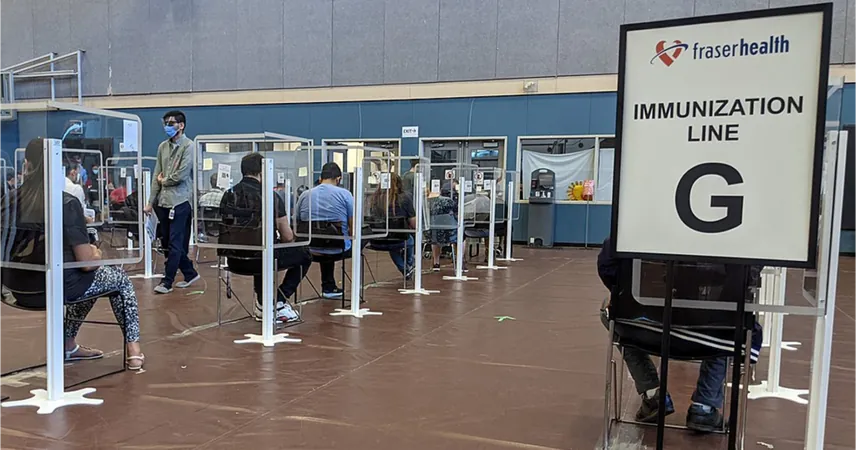
The Collapse of Hudson’s Bay: A Call for Change in Employee Protections
2025-07-07
Author: Emily
Hudson’s Bay Closes Its Doors, Workers Rally for Change
TORONTO — When Hudson’s Bay employees staged a protest in late May, just days before the legendary retailer shut down permanently, they weren’t just mourning their lost jobs; they were advocating for legislative reform to protect workers in similar situations. Their message was clear: let’s make the consequences of such corporate failures less devastating for employees.
Rallying for Workers' Rights
With their jobs already lost, the workers aimed to prompt lawmakers to consider a set of proposals that include enhancing federal support systems and changing how repayment priorities are set for companies under creditor protection. The recent demise of the 355-year-old retailer isn’t an isolated case—it echoes the previous collapses of brands like Sears and Target, and workers believe it’s time for lasting change.
Lana Payne, president of Unifor, which represents nearly 600 former Hudson's Bay employees, stated, “This is a crucial moment. The Bay’s situation is fresh, and we have a chance to push for improvements that prioritize workers over lenders.”
A Harsh Reality for Employees
Many Hudson’s Bay employees have been informed that they will not receive termination or severance pay, nor will they retain their health and life insurance benefits. The legal representation for these workers warns that due to Hudson's Bay's massive secured debts, employees may not recover any compensation.
The company attributes its downfall to the COVID-19 pandemic and declining store traffic, but as it liquidates assets to repay creditors, workers find themselves at the back of the line.
Employees Left Vulnerable in Bankruptcy Cases
In Canada, when companies declare creditor protection, employees are often among the last to receive any funds owed. Secured lenders quickly take their portion, leaving employees with uncertain claims. As Payne pointedly noted, “Workers are not the priority in these situations, and the consequences are harsh.”
The Push for Legislative Change
Moving forward, both Unifor and legal advocates for Hudson’s Bay employees are demanding a shift in priorities so that employee claims for termination and severance are handled first. Susan Ursel, a lawyer for the affected workers, emphasizes that employees often face severe personal ramifications without the negotiation power enjoyed by sophisticated lenders.
However, some fear that prioritizing employees might deter lenders from investing in companies, potentially making it harder for businesses to recover in the future.
Calls for Enhanced Employee Support
In the wake of corporate bankruptcy, former Hudson's Bay employees can access two primary federal support programs. The Employment Insurance provides limited income while workers seek new jobs, while the Wage Earner Protection Program (WEPP) offers some compensation for owed wages.
Despite these options, many advocates believe the existing support mechanisms are inadequate and need to be expanded. For instance, current limits under WEPP mean long-term employees often end up with less than they’re owed.
Awareness and Action- A Community Awakens
The Hudson’s Bay situation has shed light on the complexities of labor relations, prompting increased public awareness and discussions about employee rights. While change has been slow and fraught with setbacks in the past, activists continue to rally for reforms. Jared Ong from the Workers’ Action Centre argues, “We must persist; the tide can turn.
The Fight for Fairness Continues
As advocates vow to keep pushing for reforms, the likelihood of achieving tangible change remains uncertain. While frustration is palpable, the fight for fair worker protections is far from over.
This report highlights the urgent need for legislative reform in Canada to protect workers facing corporate failures, emphasizing that while these struggles may be ongoing, awareness and advocacy can lead to meaningful change.









 Brasil (PT)
Brasil (PT)
 Canada (EN)
Canada (EN)
 Chile (ES)
Chile (ES)
 Česko (CS)
Česko (CS)
 대한민국 (KO)
대한민국 (KO)
 España (ES)
España (ES)
 France (FR)
France (FR)
 Hong Kong (EN)
Hong Kong (EN)
 Italia (IT)
Italia (IT)
 日本 (JA)
日本 (JA)
 Magyarország (HU)
Magyarország (HU)
 Norge (NO)
Norge (NO)
 Polska (PL)
Polska (PL)
 Schweiz (DE)
Schweiz (DE)
 Singapore (EN)
Singapore (EN)
 Sverige (SV)
Sverige (SV)
 Suomi (FI)
Suomi (FI)
 Türkiye (TR)
Türkiye (TR)
 الإمارات العربية المتحدة (AR)
الإمارات العربية المتحدة (AR)